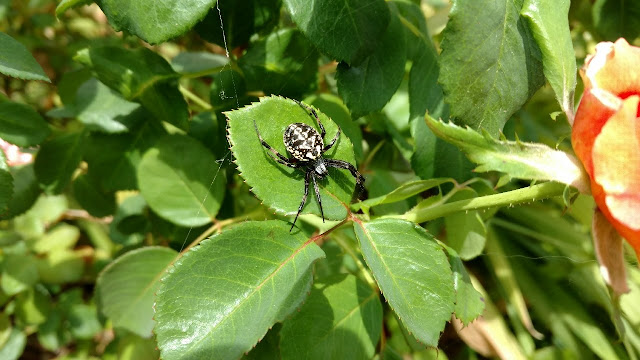
|
|
This golden orbweaver spider likes to hang out in rose bushes. It's harmless to humans. (Photo: Debbie Arrington)
|
These critters may look scary, but most won't harm people
What’s the scariest critter in the garden? Most people have an immediate answer: Spiders!
Evolution likely programmed people to be scared of spiders. According to researchers, early humans came in contact with many venomous spiders. Arachnophobia, a fear of spiders, became part of our survival instinct.
As for Halloween, spiders have been connected to witches since medieval times. Several species hang out in dark and spooky places, adding to spiders’ creepy reputation.
But in ancient folklore, spiders are an omen of good fortune. They just look scary.
I’ve encountered many arachnids over the years. Their presence actually is a good thing. Spiders are natural pest control; they eat lots of bugs.
This season, one particular spider has been making its presence known with a web as wide as our double front door. It’s a golden orbweaver, a common garden spider known for its over-sized concentric webs.
Harmless to people, this particular variety is fond of large rose bushes, such as those growing on either side of my doorstep.
“They like to hide out under leaves on the rose bush during the day,” explained Baldo Villegas, Sacramento’s Bug Man. “That’s where it’s nice and cool.”
The retired state entomologist has encountered many, many spiders. In Sacramento, we only need to worry about widows. They have a venomous bite.
“In the Sacramento area, the black widow spiders are the most dangerous as they are very common,” Villegas said. “Next would be the brown widows, but they are much less common.”
The widows tend to be found outdoors or in garages in dark, dry, seldom disturbed places. Brown recluses and hobo spiders, two other species that can hurt people, are not found in California.
Villegas likes jumping spiders (his favorite), crab spiders, garden spiders and cellar spiders (a.k.a. daddy long legs). All of them have a productive job eliminating unwanted pests.
“All spiders are predacious on other critters, especially insects, and they are considered beneficial critters of the garden,” Villegas explained. “Most all spiders in our area are harmless to humans or pets. The only problem is when the spiders are grabbed or trapped by human hands! Then is when they can bite.”
What does Villegas think is the scariest critter in his garden?
“Personally, I don't think that there are any scary critters in the garden that will harm you,” Villegas said. “However, one has to be careful reaching into darkened or protected areas where the widow spiders make their webs, which are obvious because of the confused pattern and very sticky silk.
“Also, one has to realize that some of the large garden or orb spiders construct huge webs that in my garden cover the walkways,” he added. “If one wanders in the garden and accidentally runs into these huge webs, the experience can be very scary.”
Important correction:
The website for the Placer County master gardeners that appeared in Wednesday's newsletter was incorrect. The correct link to order their 2020 calendar is
http://pcmg.ucanr.org/2020_Calendar/
. The main Placer master gardeners' site is
pcmg.ucanr.org
.

